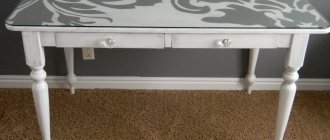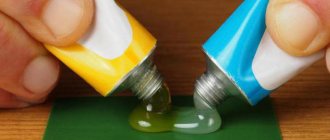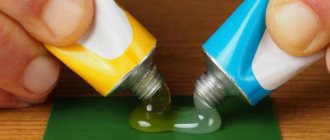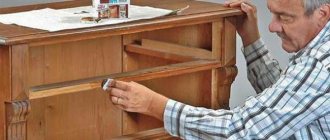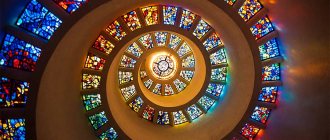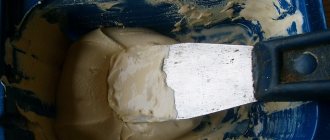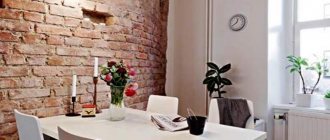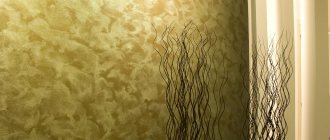Main manufacturers
Information about the main manufacturers is presented below.
Table. Advantages and disadvantages of leading brands of liquid glass for the table:
| Parameter | Comparative characteristics | ||
| DeVetro | Decosave | Silikonka | |
| Description | The film is produced at the PVC film plant for food production | Film thickness - 2 mm. Designed for kitchen tables | Designed to protect work and kitchen tables, school desks, holiday tablecloths, reception counters, store counters, and bar counters. |
| Advantages |
|
|
|
| Flaws |
|
|
|
Surface care
Washing and cleaning the coating after applying liquid glass is recommended only after seven days. There are no special rules for caring for the product; it is better to wipe it with a dry or damp cloth. If there are greasy stains on the kitchen countertop, you should wipe them with soapy water; you should not use abrasive substances, they can ruin the table.
Washing and cleaning the coating after applying liquid glass is recommended only after seven days.
You can cover the table with liquid glass yourself; this will not only help create a reliable barrier against the negative effects of moisture, but will also give the tabletop a beautiful appearance. The work does not require additional skills. It is applicable for kitchen tables, and for office and other types.
Advantages
DIY epoxy resin and unique crafts made from it
Quite often, owners of cafes and restaurants choose such tablecloths to protect tables, this is especially important for furniture made from wood. A transparent “soft glass” tablecloth on the table will not hide the wood texture and at the same time can reliably protect the surface of the tabletop
By using “liquid glass” instead of a tablecloth, the consumer will receive the following advantages.
Long service life. Such tablecloths can be used for years without losing their appearance. According to some manufacturers, the shelf life of such tablecloths is up to 50 years. Easy to use. A table with a coating is easy to clean; to do this, just wash it with an ordinary sponge.
The thing is that dirt and liquids cannot be absorbed into the surface of the coating. Since the method of laying it ensures reliable adhesion of the tablecloth to the tabletop, it will not slide on the surface of the latter, this is especially important if there are children at the table. This type of coating does not rustle and muffles the clinking of dishes. Tablecloths of this type do not wrinkle. They quickly return to their original shape. Such products meet safety requirements, since the materials used for their production are environmentally friendly
They are often used to make medical products. Products of this type are resistant to high temperatures. That is, tablecloths of this type are able to withstand temperature fluctuations from -200 to +200 degrees.
Such tablecloths can be used for years and still lose their appearance.
It won’t be difficult to order “soft glass”; just contact a specialized company.
The specialists in such a company have all the necessary information to select a flexible tablecloth and are always ready to provide all possible assistance to the consumer in choosing the required products. If necessary, they will provide all documents about the origin of the product and its safety in use.
Epoxy resin table: types and design features
Most often, countertops are made using epoxy resin. The most popular design options for such products.
| View | Image | Description |
| Baseless transparent type designs | To make these tables, resin is poured into a mold. The result is a transparent tabletop. | |
| With a base made of natural wood or chipboard | In this embodiment, the resin protects the main surface from moisture and mechanical damage. | |
| Combined | The use of pouring and natural wood in various combinations and combinations is a favorite design technique. |
Let's look at the features of the listed varieties of epoxy countertops.
Transparent structures without supporting surface
For the manufacture of such structures, a casting mold is used. It can have the most bizarre geometry - the more complex, the more interesting. These countertops are most often used to create coffee or coffee tables. Craftsmen use built-in neon lighting and add inclusions of natural materials to the fill. Adding water to the filling looks especially impressive - you get real “cosmic” objects. Considering the lack of a base, you need to treat tables made of liquid glass with care and not subject them to excessive load.
Interesting ideas for countertops made of wood and epoxy resin
Epoxy does not necessarily have to be colorless - to decorate furniture it can be tinted or even made matte. Moreover, all inclusions in such a product will be clearly visible even through a thick layer of chemical glass. An interesting idea is the use of luminescent dyes. The surface of a base, such as a tree branch, is treated with a substance that can glow in the dark. After pouring, you get a very original product.
A favorite technique of designers is to frame a wooden tabletop with epoxy filling. Even boards from old boxes can be used as a base.
An original design option is obtained if you use laminated chipboard with a marbled coating as the base. No less impressive are paintings and still lifes, which are used as the basis for filling the tabletop. In short, the design options are endless. Epoxy resin allows you to create and imagine – this is its main advantage. Here are just a few photographic examples of tables made of epoxy resin and wood.
Advantages and disadvantages of epoxy countertops
DIY epoxy resin at home
Epoxy resin is a chemically complex multicomponent product that has become actively used for decorative purposes relatively recently.
The advantages of this material attracted the attention of furniture manufacturers:
- high strength and resistance to deformation and ultraviolet radiation, absence of chips and cracks during operation;
- relatively low price for the starting material;
- the surface is resistant to the destructive effects of moisture;
- ease of care;
- possibility of a wide variety of processing and filling;
- visual expansion of space due to the glossy finish.
The decorative characteristics of the material allow you to create real masterpieces
Epoxy tables also have their disadvantages:
- high price for finished products. Most of the works are of original origin, so the price is determined by the master;
- special requirements for manufacturing technology. The slightest mistake leads to irreparable defects.
Finished products do not tolerate treatment with abrasive powders and detergents and are afraid of hot objects
Application of liquid glass for tables and countertops
The requirements for furniture are different, but the most important are practicality and pleasant appearance. Liquid glass tables are becoming increasingly popular. After all, it meets these two criteria and creates a reliable coating that will look beautiful. This material will be discussed in more detail below.
How to make a countertop from epoxy resin with your own hands, step-by-step instructions
The most famous manufacturer of table film in the world is the Japanese company Meiwa. They provide clear, colored, matte overlays to the market. , both in large rolls and in standard tabletop sizes.
In terms of their positive qualities, glass table films from domestic manufacturers do not lag behind Japanese ones. Decosave and Modern companies produce both transparent overlays and tablecloths in various shades and patterns, which allows you to match them to any interior.
“Ofiston” is considered the best company in Belarus that produces thick transparent film for the table. Their transparent tablecloths have gained popularity among customers, which indicates the high quality of the product.
Everyone has probably heard about the Swiss company Ikea. The quality of this company's products is evidenced by many positive reviews. The models of table films that are most quickly leaving the shelves of the Ikea store are the transparent “Preuss” and “Skrutt”.
The following companies are also successful in selling silicone tablecloths:
- Durable;
- Esselte;
- Leitz.
Where can you buy a table made of wood and epoxy resin
Such products, as a rule, are original works. Therefore, you can find such tables on handicraft websites.
You can order a table according to your own design in the designer’s workshop
There are several online stores offering mass-produced products. It is better to choose those that are located in your city. Long-term transportation of such items usually has a bad effect on their condition.
Features of use
The packaging must be removed very carefully. The use of any sharp objects, especially scissors and knives, is prohibited.
In order to get the product you need:
Carefully grasp the edge of the tape. Pull it towards you. Remove the remaining film. Clean the tablecloth from dust.
Laying the material
Flexible glass is installed on a stone, metal or wooden surface as follows:
- Place the film on the table.
- Moving towards the edges from the center, press down. This will help avoid air bubbles.
- Wipe the table covered with liquid glass with a damp cloth.
The film is laid on a tabletop made of glass as follows:
- Clean the surface from dirt.
- Place a tablecloth on the table.
- In places where bubbles collect, spray with water from a spray bottle. Against the background of additional moisture, the tablecloth quickly sticks to the tabletop.
Trimming material
In order to cut the glass to the required dimensions, you will need the following tools:
- roulette (ruler);
- marker;
- knife (stationery).
The film is cut on a cutting board.
The instructions look like this:
- Measure the countertop.
- Make patterns on paper.
- Cut out the material.
- Cover the table.
It is necessary to measure the tabletop several times. You need to use the average value. When cutting a layer, you need to take into account the errors that appear as a result of measurements. This will help avoid damage to the material.
Trimming is carried out using a stationery knife, small defects are eliminated with scissors.
General information
The oilcloth for the table is made from laminated protective transparent PVC film. Production - South Korea.
The product has a shiny laminated surface and reliably protects the table from any damage. The oilcloth structure is flexible and durable. It is tear-resistant, practically does not wrinkle and cannot be cut with a knife. Soft glass remains transparent for a long time and retains all its properties.
Thanks to the flexible tablecloth, wear and tear on the tabletop is reduced. Dust on the surface covered with a protective film is practically invisible, any dirt can be easily wiped off without scratching or staining the table material.
Flexible glass is intended for use:
- in any office;
- in the kitchen;
- in the dining room;
- in a restaurant (cafe).
Which table is it suitable for?
Protective film is suitable for all types of tables, but is especially relevant for glass and lacquered ones. The tablecloth protects the kitchen table from cuts, the desk from rubbing, and the dining table from accidental stains.
It can also be any table in shape:
- rectangular;
- square;
- round;
- oval;
- non-standard shape.
Main characteristics
Before purchasing the product, you must select the thickness:
- 1.2 mm is used to protect chests of drawers, window sills, children's and school tables;
- 1.8 mm is well suited for the kitchen (protection of tables and countertops), children's (protection of desks) and office (protection of tables and window sills);
- 2.2 mm is designed to protect large surfaces and helps emphasize the premium quality of the interior.
Liquid glass on the table has the following characteristics:
- Duration of operation - up to 5 years;
- transparency - 98%;
- hardness - 37;
- blue pigment that protects against yellowness;
- resistance to sunlight;
- food standard - the material is allowed for contact with food;
- synthetic smell - absent;
- There are no heavy metal impurities in the composition.
Advantages of flexible glass
Main advantages of the product:
- easy to trim after shrinkage;
- has a comfortable temperature range - from –20 to +80;
- merges with the surface;
- just spread out;
- does not slip, lies well under its own weight;
- greasy stains are not eaten away;
- any dirt is easily removed.
If you want, you can decorate the tablecloth. Any stickers can be easily attached to the silicone surface. You can also paint it with permanent paint, or attach fringe around the perimeter.
Main disadvantages
Over time, the film may shrink. This happens even against the backdrop of careful operation and proper maintenance. The color of the film becomes cloudy, and the product itself takes on a sloppy appearance.
The deformation cannot be corrected, and therefore you have to purchase a new tablecloth.
How to choose liquid glass for a table
The invention of this material belongs to Professor Johann Fuchs. He made his discovery in 1818. Today, only the technological processes have changed.
The polymer does not turn yellow, does not crack, and does not separate from the wood. Easy to clean, scratch resistant. It is distinguished by its lack of toxicity, environmental friendliness and safety for the environment. It can be left transparent or painted in any desired color.
Liquid glass is based on potassium or sodium silicates.
- Sodium has high adhesion and stickiness. Not afraid of temperature changes. Area of use from reinforcing foundations to treating trees and shrubs.
- Potassium glass has the same characteristics, but does not produce glare. Can be used for external repair work.
To treat wood you need to use a sodium solution. Choose liquid glass for the tabletop from these enamels:
- alkyd PF-115;
- chlorinated polyethylene, also known as HP;
- urethane-alkyd UR-49.
They provide reliable protection against moisture.
Manufacturers
There are eight largest Russian companies:
- "KUBANZHELDORMASH". A large machine-building enterprise that has been operating since 1933. Epoxy resin has been produced since 2007.
- "TRADE HOUSE GLASS PRODUCT". Ryazan enterprise, whose products were used in the construction of facilities in Sochi.
- "METTERRA". The company produces only sodium liquid glass.
- "OXIUM". They work according to GOST. If necessary, a composition with any characteristics will be produced.
- "CONTACT". In addition to the ready-made polymer solution, it is made in powder form.
- "IVKHIMPROM". In addition to production lines, it has its own research. Founded in 2009. One of the leaders in the production of liquid glass.
- "ALECTICH". Founded in 1992 for the design and construction of buildings in difficult natural conditions. We opened an epoxy production line for our own needs. Today, production volumes allow it to be sold to other companies.
Construction stores offer a large selection of manufacturers. If the composition is manufactured in a factory setting, then there is no fundamental difference. But it happens that the legal address and name are not indicated on the packaging. It is better to refrain from such a purchase, it may be counterfeit. If the solution is sold in a transparent container, there should be no flakes, heavy sediment or lumps.
How to choose liquid glass
A tabletop made of liquid glass will look and have the necessary properties if only the silicate adhesive is selected correctly. Initially, it is worth reading customer reviews of individual products, from which you can understand how this or that product performs.
It is better to choose products from well-known manufacturers; you should pay attention to the storage method and conditions of transportation of the material. If they are violated, the quality of the resulting product will be reduced. Among the most popular manufacturers of silicate glue are: Kubanzheldormash, Alektich, Trading House Stekloprodukt, Mettera, Silikat. All these are domestic brands.
It is preferable to leave the choice on transparent packaging, through it it will be visible whether there are sediments, various impurities, or clumping in the product. It is better to choose the option without them.
Finding a factory product is not difficult, because there are many of them on sale. It is better to choose these products; if there is no marking on the packaging, then it is probably a fake, the quality of which is unlikely to be good.
Why is it necessary?
Protective glass on the table has gained wide popularity, as it has a number of functional features:
- Maintains the ideal appearance of the countertop surface, protecting it from scratches and dirt. This is especially true for the desk of a young schoolchild or preschooler, who, having played out and got carried away, can scratch it or stain it with paints or markers that are difficult to wash off while drawing.
- Removes small flaws and defects that appeared on the desk during its long-term use.
- Thanks to a variety of design options, this element can easily fit into any room interior.
- Thanks to the glass surface, such a product can visually expand the space, which is important for small rooms, for example, a nursery or an office, which are often quite modest in size.
Please note that plexiglass for a school table has a number of advantages over other similar elements, especially when compared with ordinary glass. The main positive qualities include the following:
- Practicality. Plexiglas is highly durable. Even if this material falls, it will not break. In addition, glass has protective properties, protecting the tabletop not only from mechanical damage, but also from moisture.
- Ease. This plexiglass is lightweight, so even a small child can lift it independently.
- Safety. It is provided not only with impact-resistant material, but also with rounded edges that will protect the baby from injury.
Despite the fact that regular glass is much cheaper than other overlays, it is not recommended to place it on a school table, especially if a small child is studying at it. This limitation is due to the following:
- It is very fragile: if it falls on the floor or if a heavy object falls on it, it will crumble into small fragments that can injure the child;
- Sharp edges can injure your child.
Usually, for a student’s desk, a special overlay is used, made of transparent material, which fully matches the size of the table top or can be small in size, partially taking up space on the table.
Which stage to use for what?
Epoxy resin for countertops comes in several thicknesses, and each is suitable for different purposes.
- Liquid stage: the composition flows freely from the stick. Ideal condition for pouring molds - at this stage all corners and depressions will be filled.
- Thickness like “liquid honey”. It flows viscously from the sampler, lingering at the tip. Exactly what you need to create drops and lenses. Also suitable for filling soft shapes, for example, for a round tabletop.
- “Thick honey” stage. It is practically unsuitable for pouring, but it is impeccable as an adhesive - previous consistencies will run off.
- The next stage, in which the resin is separated from the total mass with difficulty, is of little use for any purpose. Either they don’t bring it to this point, or they wait for it to thicken even more.
- The rubber phase allows you to create fancy shapes, like modeling from plasticine. True, in order for the epoxy resin for the countertop to retain its shape, it will have to be fixed in the desired position, otherwise it will straighten out.
The last stage is solid. When the epoxy reaches it, your countertop is ready.
How to pour epoxy resin on a countertop with your own hands and make a table
Making tables from wood and epoxy resin is not an easy job, requiring extreme care and some knowledge about the properties of this material. Before we begin to consider the question of how to make a table from epoxy resin, we will consider all the features of the future pouring.
How to choose and prepare epoxy resin for pouring countertops
Epoxy resin consists of two chemically active components: a resin and a hardener. While they are in separate containers, they remain elastic. After combining the components, the composition hardens.
The cost of filling is in the range of 300-900 rubles per kilogram, depending on the manufacturer
It is more profitable to buy resin in large packages from wholesalers. Nowadays it’s not difficult to find such retail outlets: epoxy is used not only for pouring furniture, but also for decorating colorful floors. What brands of resin are suitable for the job:
- Art-Eco. The material from this manufacturer is suitable for pouring thin layers. You can buy branded colors to give different shades.
. QTP-1130 - the composition is suitable for the thinnest filling up to 3 mm. It is famous for its transparency and self-leveling.
Each manufacturer places instructions on the packaging for preparing the composition. Typically, one part hardener is added to two parts resin. There are exceptions, so you need to carefully read the instructions and test the mixture on a small object before pouring a large product. We invite you to watch the video below on how to make your own epoxy resin filling for a table:
Concluding the topic of choosing a material for filling, here are a few reviews from forums on the use of epoxy.
More details on Masterforum.Composites: https://masterforum.composites.rf/viewtopic.php?f=5&t=380
More details on Forum.Woodtools: https://forum.woodtools.ru/index.php?topic=74117.0
More details on Forum.Woodtools: https://forum.woodtools.ru/index.php?topic=74117.0
Master class on table filling
The manufacture of such a product begins with the search for a suitable material for the base. It can be a simple board with an interesting texture, branches, saw cuts, pallet boards or a sheet of fiberboard.
Illustration Description of action Before starting work, decide on the type and brand of fill
Try different compositions in combination with the selected wood and choose the best one. An important condition for high-quality pouring is an even shape with sides and a coating that does not stick to the resin. The installation of the mold must be checked using a building level. To ensure that during the drying process of each layer dust does not settle on the resin, you will need to prepare a cover for the mold, for example, a sheet of plywood. The wood for pouring must be processed, sanded and covered with stain and varnish. Place the wood in the mold and check its location with a building level
Fix the material securely. The process of mixing the fill does not tolerate fuss. Use a drill attachment to mix and repeatedly pour the mixture from bucket to bucket so that no unmixed components remain on the walls. Carefully pour the first layer of epoxy. Check the thickness of the fill with a ruler. The manufacturer's instructions indicate the maximum thickness. If it is exceeded, the resin may boil or become deformed during drying. Air bubbles formed during the process are expelled with a plastic fork or a needle. After the first layer has hardened, the surface is wiped from dust with a rag with acetone. Perform the second and subsequent layers of pouring in the same algorithm. The last one the layer is the thinnest, it is applied with a brush. After complete hardening, you can cut and sand the edges of the tabletop.
How to apply liquid glass to the table: technology
To cover the tabletop with liquid glass, we recommend using the manufacturer’s instructions. It describes step-by-step actions that will guide you in the principles of operation.
Prepare the necessary equipment. It is better to keep it at hand so as not to be distracted.
Tools
To work you need to stock up on the following equipment:
- bucket for construction work;
- a drill with an auger-style attachment that will stir the thick solution;
- brush;
- cement mixture;
- sifted fine sand;
- pure water;
- spatula made of metal or plastic.
To ensure the job is done efficiently, do some preliminary preparation. The master needs to create a full-fledged glass coating effect. To do this, first ventilate the room, then eliminate dust and drafts.
Treatment
Before applying the diluted mixture, the wood must be leveled and cleaned. First, the surface is treated with an antiseptic primer, then puttied to fill all the cracks.
Next, the wood is sanded to remove knots and level its surface. It is better to do this with a grinding machine. You can also use coarse sandpaper, but then the work will take much longer.
When sanding is complete, the wood is coated with a finishing penetrating primer. To apply it evenly, we recommend using a roller.
Application
The table is covered with liquid glass in several layers. There should be at least two, but the more, the better. The second and subsequent balls can be applied only after the previous ones have completely hardened.
Principles of material application:
- The composition must be diluted with clean running water in the ratio specified by the manufacturer.
- Apply it evenly using rollers or brushes of different sizes.
- The material is placed in two or more layers.
- During this process, small air bubbles will appear on the surface. They are removed by heating with a blowtorch. Do this more carefully with vertical surfaces, because when heated, the material becomes more fluid.
- The solution must be poured from the central part to the edges using spiral movements. If necessary, the master can level the coating with a spatula.
- If work is carried out with horizontal coverings, it is better to level the work area. Or there is a possibility of uneven distribution of the mixture.
- Application must be quick as it hardens quickly. The master has no more than twenty minutes for all actions.
Final stage
The final stage is drying the product. This takes approximately one day. The time depends on the material used and its manufacturer.
It hardens completely at room temperature. Avoid vibrations and other mechanical influences to avoid defects in the coating.
Requirements
It should be noted right away that you won’t be able to save on material. Those resin modifications that are low cost are unlikely to be suitable for creativity, since they do not meet the requirements presented below. Among the technical parameters, the minimum layer thickness is of practical importance. No craftsman needs instant hardening of the resin. After pouring, the compound should have time to fill all the cavities, and air bubbles should come to the surface.
In addition, if there is decor, you may need to make some adjustments to its placement. If you take resin in a volume less than recommended, it will begin to set very quickly, which will negatively affect the quality of the product. As a rule, the first layer of resin is used to fix the decor at the base of the tabletop.
Many beginners prefer to choose brands of resins that allow them to fill the countertop in one go, but there is a certain nuance here.
- Firstly, layer-by-layer filling allows you to create three-dimensional images when decorating each layer.
- Secondly, the large volume of resin that has to be poured at one time can cause intense heat generation during curing.
Useful to know > What is epoxy glue and where is it used?
If the master decides to opt for a resin with a maximum layer thickness of 5-6 cm, then preference should be given to those models that have a long lifetime, because it guarantees a low reaction rate of the interaction of the components.
Typically, final curing takes about a day. However, you need to read the instructions to clarify this parameter. The fact is that the next layer can be poured only after the previous layer has completely cured. The remaining selection criteria are related to the cost and popularity of the manufacturer. If the cost is very easy to determine, then the rating of manufacturers and suppliers will have to be studied additionally. It is useful to take advantage of the advice and tips of experienced craftsmen. We will give several examples of popular brands that, in all their parameters, meet the requirements for filling countertops.
Features and characteristics of transparent film for the table
“Liquid glass” is a durable film for table protection, made using modern technologies from polyvinyl chloride.
It gained its popularity due to its advantages:
- remains almost invisible, without covering the color and design;
- a transparent film on the table will protect it from exposure to ultraviolet rays, moisture and household chemicals;
- it is heat-resistant and does not deform from high temperatures.
- “liquid glass” is suitable not only for the kitchen, but also for the office. It will protect the work surface from scratches.
- You can attach photographs, phone numbers, and necessary documents under a transparent thick film.
Transparent film on the table: before and after pasting
PVC material from which soft glass is made:
- hypoallergenic;
- flame retardant;
- wear-resistant;
- withstands low temperatures, up to – 15 degrees.
When folding and transporting, no creases or cracks form on the silicone film. An unpacked tablecloth easily takes on its original appearance.
Liquid glass: composition and scope of application
Liquid glass is, in fact, a modern silicate glue, available at any hardware store. It contains water-based sodium or potassium silicate. The invention of 1818 was credited to Jan von Fuchs. This scientist mixed alkali and silicon acid and obtained a substance that resembles liquid glass in its physical properties. Subsequently, many researchers and inventors turned to the question of how to make liquid glass. For example, there is a known variant of alloying ordinary river sand and soda, carried out at very high temperatures.
Silicate glue in the form of a ready-made mixture is diluted with water in the proportions specified in the instructions. The resulting thick solution is used for its intended purpose for gluing. Possessing strong adhesive characteristics, it penetrates deeply into the upper layers of the surfaces to be bonded. It can handle almost any material, from paper, wood, rubber, to ceramics and glass.
It is used as protection for a variety of materials due to its antiseptic properties. For example, it is used for external processing of objects made of plaster and wood. Serves as a reliable barrier against moisture, dust, mold. Homemade plaster sculptures coated with liquid glass can be placed in a garden or park without fear of damage from the external environment.
Alternative options
The tabletop can be covered with a “liquid” tablecloth or soft oilcloth. This is a transparent or multi-colored polyvinyl chloride film.
It tolerates moisture, dirt and mechanical stress well. The advantage is a tight fit and ease of application. All you need to do is clean the table, wipe it dry and put on a PVC cover.
Care Tips
Craftsmen do not recommend soaking or washing the coating earlier than a week after it hardens. At the same time, there is no special care. The frozen surface can be wiped with a damp or dry cloth.
If greasy stains are found, they are wiped off with soapy substances. The material does not get along well with abrasives, so contact with them is also undesirable.
Coating surfaces made of different materials
The surface of the countertop is covered with silicate solution in several layers. The minimum number of layers must be two. A new layer can be applied only after the previous one has had time to dry completely.
Instructions for diluting and applying the composition can be read on the product packaging; you should definitely read it, because each type may have its own nuances.
Step-by-step operating procedure:
Complete drying occurs in approximately 24 hours; the manufacturer indicates on the packaging the required time for drying the table. The room should be kept at normal room temperature.
It is necessary that the product is not subjected to mechanical stress and vibration at this time, otherwise unwanted defects may appear on the coating.
When covering other types of surfaces, such as concrete, plaster, brick, they are also pre-cleaned and leveled. If the surface is wet, wait until it dries completely. Often, a special solution is prepared for such materials, which includes cement, water and silicate glue. To process metal products, liquid glass and cement are mixed in equal proportions.
Instructions for treating surfaces with liquid glass
1. Clean the surface required for treatment from dirt and dust. Any contamination, including old coating, debris and dirt, will significantly impair the ability of liquid glass to be absorbed into the surface.
2. Prepare a silicate-based primer and apply the mixture to the surface using a roller or brush. This layer should be absorbed.
3. After an hour, apply a second coat of primer. This time period is enough for the previous layer to be completely absorbed and dry. Unlike the first, the second layer will lay down as an even film.
4. Prepare the waterproofing mixture and spread it over the surface with a spatula within 15-20 minutes.
5. After completing the work, thoroughly wash your hands and all tools that came into contact with these mixtures.
After the liquid glass dries, a dense film forms on the concrete. But it dissolves in water, so it just washes off
Make a very small batch. Even less than with alabaster. No more than 500 grams. The dry components (cement and sand) are mixed and the required amount of liquid glass is added to the liquid. For repair fillings, the quantity is 10% by weight of M400 cement. The quantity is measured strictly on scales. Water and liquid glass are poured into the mixture of dry ingredients and quickly brought to homogeneity.
Making a batch with liquid glass for an instantly hardening filling - yes
The solution is applied very quickly to the damage. From the moment of mixing to the moment the hardening begins, it only takes a few minutes. To be safe, we can assume that it is one minute. You can hold the patch through the film with your hand or support it with something if the area is large. Once set, the patch holds water. To prevent it from crumbling, it is rubbed down with cement.
The concrete surface is treated with liquid glass if it is necessary to increase its resistance to water. Then the laid or not completely hardened concrete is simply treated (painted) with a brush dipped in liquid glass. Really helps. A dense and durable film is formed on the surface, but under load it can crack.
The use of liquid glass as a temporary solution - treatment of concrete walls
So liquid glass in concrete, and even as surface waterproofing, is already a thing of the past. Over time, the film either cracks, wears off, or dissolves. There are different types of impregnations and additives with which it is much easier and more reliable to obtain the required properties. And the price isn't that different. So why is it still recommended to add it?
Varieties
Silicate glue is produced in two varieties; they differ in their characteristics. Liquid glass does not flow, is stable, stays on the surface for a long time, and does not turn yellow over time.
Types of glass:
- Containing sodium, it is characterized by high adhesion to various materials and resistance to high temperatures, including sudden changes in temperature. Can be used for reinforcing work on the foundation, for decorative purposes and for treating trees;
- Containing potassium, the properties are similar to the previous type. The coating obtained from this type is characterized by the absence of glare, so it can be used to cover the outside of houses.
For wooden products, it is better to choose the first type of material; it has been experimentally proven that such a coating will create a reliable barrier on the surface from moisture, and the wood with it will not rot.
Liquid glass does not flow, is stable, stays on the surface for a long time, and does not turn yellow over time.
What is the name of?
A specially designed element that is designed to protect the surface of the table is called plexiglass. This table glass can also be used as a decorative element if it depicts an intricate design or pattern. Plexiglas was a fairly popular attribute, which was actively used in the 80s of the last century. At that time, almost every desk had glass, under which it was customary to store various notes, postcards, photographs and other necessary and useful notes.
This functional glass for the table has not lost its relevance even now. Having undergone some changes, it again finds its supporters and gains popularity both among adults, who keep reminders and notes under it in the old fashioned way, and among young people, who use its non-slip surface to work with the mouse on a computer and laptop.
Features of care
Despite its resistance to the adverse effects of chemical compounds, liquid glass is a soft material. Proper care helps extend its service life.
Basic Rules:
The water temperature for processing the tablecloth should be room temperature or about 40 °C. This helps accelerate the impact of detergents; The material can only be wiped with soft cloths and napkins. Products made from microfiber and flannel are best suited. You can also use sponges made from foam rubber. There should be no hard inserts; After cleaning the surface, it is necessary to remove any remaining detergent. This will help reduce the risk of clouding and streaks; the surface must be treated with gentle liquid agents - solutions and gels
Do not use preparations with active granules, as well as hard powders; severe contamination must first be treated with the product, then left for 5-15 minutes, only then carefully wipe with a soft cloth. You can't put in any effort.
It is advisable to purchase a tablecloth on the official website of the manufacturer, because counterfeits may be sold in retail stores. Before purchasing, you should carefully study the reviews and reputation of the manufacturer.
Liquid glass on the table is a good solution for both the kitchen, children's room or office. The main advantage is resistance to moisture and abrasion. Such protection is especially useful for glass and polished tables. On a desk, such a film will successfully replace plexiglass. It is transparent, but impenetrable to dust, water and various contaminants, so it will extend the life of the countertop.
Liquid glass: types, composition, properties
This material is made in two types, each of which is characterized by certain properties. Liquid silicate glass is resistant and durable. It does not crack, does not lag behind the wood, and does not turn yellow even after a long period of use.
This material is environmentally friendly. It does not emit toxic substances, therefore it is safe for nature and humans. The composition can be left transparent or painted in any color with dyes.
Divided into two categories:
- Sodium. Properties: high adhesion to different coatings, adhesiveness. Resistant to temperature changes. Can be used to reinforce the foundation of a building, for decorative purposes, to treat shrubs and trees.
- Potassium. The characteristics are similar to sodium. The main difference is the absence of glare. Therefore, it can be used to decorate the exterior facades of houses.
To treat wood, we recommend using a sodium solution. The craftsmen made sure that it protects the wood from excess moisture and prevents the material from rotting.
Application area
Before working with this composition, many novice craftsmen think about where exactly it can be applied. Liquid glass interacts with the following coatings:
- Tree. Adhesion with it is very high, so the liquefied product is used for designing wooden furniture and decorative structures.
- Metals. The material adheres well to metal products.
- Concrete. The product is widely used for waterproofing foundations, concrete structures, etc.
Liquid glass interacts relatively poorly with plastic. After all, a plastic coating cannot always withstand the heavy weight of the material. Therefore, the products will not be of high quality.
What is liquid glass used for?
First of all, it must be emphasized that the material is environmentally friendly and safe for human health, so using it to cover furniture, especially those located in the kitchen, is advisable. Liquid glass on the table can be used in a transparent form, or painted in the desired color.
This material can be used to cover several types of surfaces:
- Wooden, the adhesion of silicate glue (the second name for liquid glass) to wood is high, so it is often used for wooden furniture and other wooden elements;
- Metal ones, adhesion to metal is also high;
- Concrete, most often it is applied to concrete structures to improve waterproofing properties.
Application on plastic products is less desirable; the plastic may not withstand the weight of such a fill, and will reduce its strength.
The use of additional means to protect wood is necessary to prevent negative effects:
- Humidity of air, water;
- The process of decay;
- Fire;
- Harmful insects;
- Aggressive chemicals.
Coating with different substances will help extend the life of wooden products; liquid glass for the table will create a water-repellent barrier.
Advantages of the material
What is especially good about epoxy resin for pouring countertops is that when it dries, it retains its original volume. Varnish, for example, dries due to the evaporation of the liquid entering it. As a result, its layer shrinks, which often creates problems. The hardening of the resin is caused by a chemical reaction. And if you require a lens by design, you will get it. Moreover, it will not be subject to chips, removal, or deformation. And just a flat surface will remain flat, without sagging as it dries.
Another advantage that epoxy resin has is price. The material is cheaper than others designed to create durable surfaces. The cost on average ranges between 200 and 280 rubles per kilogram. And if you need epoxy resin in bulk, the price will drop to 180-190, depending on the size of the batch.
Review of manufacturers
The well-known and popular brand Ikea, specializing in the production of high-quality furniture, did not ignore plexiglass for the table. This manufacturer offers several options for such countertop overlays.
“Rissla” has a stylish and elegant appearance; the discreet execution of this product has won many fans among the male half of the population. Such a product will look natural both in the office and in the apartment. This overlay is produced in black color. As a decoration, decorative white stitching is used, which frames the edge of this product. It has a special bend located along the front edge, so that the pad does not slide off the surface of the tabletop.
“Riessla” is made from durable polyurethane, and therefore has high wear resistance characteristics. This product is not afraid of scratches or spilled hot coffee. The length of this overlay is 86 cm and the width is 58 cm.
“Prois” – transparent plexiglass on the table. This product is slightly smaller in size than the Rissla model from Ikea. Its length is 65 centimeters and its width reaches 45 centimeters. Made from ethylene vinyl acetate, which is an environmentally friendly material. This pad is characterized by increased wear resistance, in addition, it is not afraid of the influence of aggressive chemicals, so you don’t have to worry about scratches or stains appearing on its surface.
By placing important notes under this plexiglass, you will not only have the necessary information in sight, but also protect it from damage and contamination.
The “Skrutt” model refers to silicone pads. Its dimensions are 65 cm in length and 45 cm in width. It is produced in black color. This product also has high wear-resistant characteristics. To remove dirt, use a dry cloth.
The “Skrutt” and “Preuss” models from the Ikea brand have an affordable price, so anyone can purchase such an overlay. Despite the rather high cost of the “Riessla”, it will emphasize the refined taste and status of its owner.
How to choose the right one?
When choosing plexiglass for a table, you should pay attention to some points:
- The thickness will depend on the purpose for which the glass is purchased: if as a decorative decoration, then you can opt for a thin product; if the main emphasis is on the protective function, then preference should be given to a thicker model.
- If the length of the plexiglass is not enough to cover the entire tabletop, then you can combine several separate overlays.
- Rounded or sharp corners. If a product is purchased for a schoolchild’s desk, then it is better to give preference to a model with rounded corners in order to protect the child from injuries and damage.
- Glass on a table can not only decorate the tabletop, hide minor imperfections in the surface, but also become an indispensable and functional attribute in organizing the work process of both a schoolchild and an adult.
How to give a second life to a glass table? Watch the next video about this.
